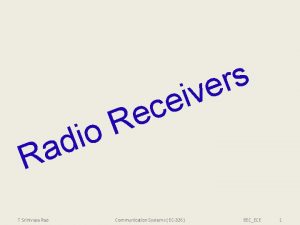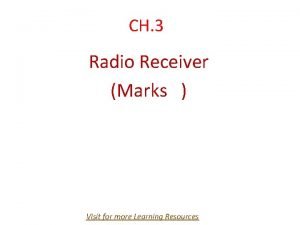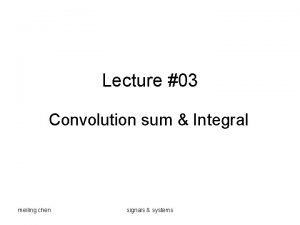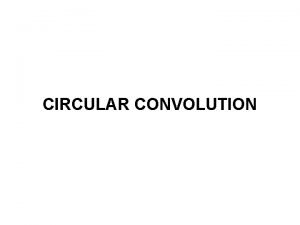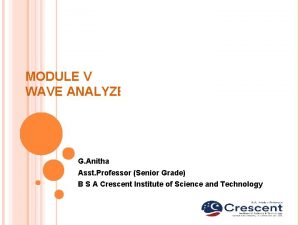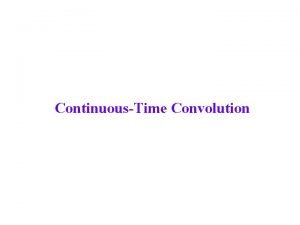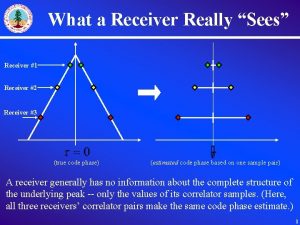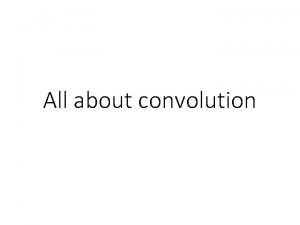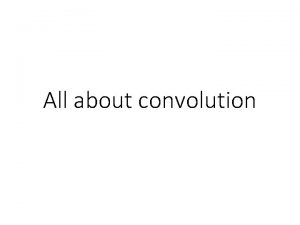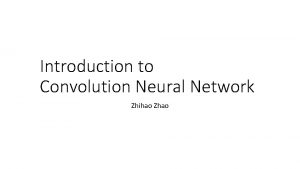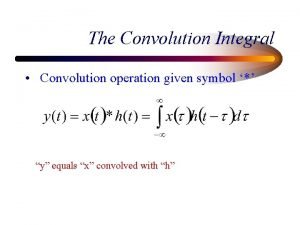Superheterodyne Receiver Multiplication in the Time Domain Convolution












- Slides: 12

Superheterodyne Receiver Multiplication in the Time Domain = Convolution (shifting) in the Frequency Domain Mixer RF Front End (Amps, Filters) IF Strip (Amps, Filters) Service Band Channel Selectivity Local Oscillator Detector (Demodulation) Recovered Information

Image Effect -w 1 Local Oscillator w 1 w 3 -w 2 = w 2 -w 1 -w 2 -w 3 -w 2 w 3 w 1 -w 2 -w 1 +w 2 -w 3 +w 2 w 3 -w 2 w 1 +w 2 +w 3 +w 2

Image Effect (cont) BWIF Lower Image Desired Conversion Band Channel Band f. IF f. LO - f. IF Any signals entering the mixer in the Desired Channel and/or the Image Band will be converted down into the IF bandwidth, amplified, and demodulated. Upper Image Desired Conversion Channel Band f. LO + f. IF High Low Side Injection This includes: 1. Desired and interfering (image band) signals entering the antenna 2. k. TB noise amplified by the RF amplifiers

Observations The desired channel and its image band are always separated by twice the IF frequency. . The LO frequency is always exactly between the desired channel and its image band, Upper Conversion Band Lower Conversion Band f. LO - f. IF f. LO + f. IF

Observations (cont) The higher the IF frequency, the greater the frequency displacement between the desired channel and its image band. f. IF f. LO - f. IF f. LO + f. IF

Observations (cont) Filtering (pre-selector) before the mixer, in the RF front end, can reduce the effects of image band signals and k. TB noise. LO Range Pre-selector Response Worst Image Case Rejection Imagefor. Rejection DS Image Band Range US LO DS Service Band Range

Pre-selector Math BWS : Pre-selector Passband ~ Service Band Range fs, MIN DS Image Rejection for DS 2 f. IF US Worst Case Image Rejection fs, MAX DS fc : Center of Service Band Pre-selector pass-band Image Rejection Shape factor for Specific Channel DS: Worst Case Image Rejection Shape Factor (Low-side. Injection) (High-side

Image Band Thermal Noise A pre-selector filter between the antenna and first RF amp limits all out of band interfering signals entering the receiver, including images. . . But does not reduce thermal noise in the image band. Absent additional mitigation, this will allow thermal noise power equal to k. T 0 B from both the image band desired channel to enter the mixer and pass through the IF. This effectively doubles the noise bandwidth , and the effective noise power entering the receiver is 2 k. T 0 B, where B is the IF bandwidth. If a second pre-selector is included following the first RF amplifier, the amplified thermal noise in the image band can be reduced to well below the amplified on-channel thermal noise (which we can’t do anything about), effectively eliminating it, as well as providing additional image rejection. Mixer Pre-selector RF Amp

Effect on Noise Figure When determining the noise figure/ratio of the receiver, structure and the placement of the pre-selector filters must be taken into consideration. If a pre-selector is included between the first RF amp and the mixer, there is no appreciable noise power contribution from the image band, and Friis’ formula will provide an accurate noise ratio. If there is no pre-selector between the first RF amp and the mixer, then the result of Friis’ formula must be doubled (add 3 d. B to resultant noise figure) to account for the excess noise contribution from the image band.

Computing Image Rejection 1. Determine the shape factors for the desired frequency and image frequency (mid-band or band edge) for all pre-selectors (they may have different bandwidths). 2. Based on the poles/ripple of each pre-selector, determine the attenuations corresponding to the shape factors determined in step 1. 3. The image rejection for each filter is the difference between the attenuation for the image and the attenuation for the desired frequency. 4. The total image rejection in d. B is the sum of the image rejections in d. B as determined in step 3.

Example Service Band: 118 – 124 Mhz IF: 9. 4 Mhz, Low Side Injection Mixer Pre-selector A RF Amp Pre-selector B RF Amp Pre-selector A: fc = 121 Mhz, BW 3 d. B =8 Mhz 2 Poles, 0 d. B ripple Pre-selector B: fc = 121 Mhz, BW 3 d. B = 7. 5 Mhz 3 Poles, 0. 1 d. B ripple QU = 80 BW 3 d. B Image Band BWS : 6 Mhz 18. 8 Mhz Worst Case Image Rejection US: 105. 3 Mhz DS: 124 Mhz fc : 121 Mhz

Worst case Image Frequency: 124 Mhz – 2(9. 4 Mhz) = 105. 3 Mhz (FM Broadcast) Preselector SF@ 124 Mhz Att(d. B)@ 124 Mhz SF@ 105. 3 Mhz Att(d. B)@ 105. 3 Mhz IRR(d. B) Ins Loss (Midband) Ins Loss@ 124 Mhz A 0. 74 1. 1 -4. 22 25 23. 9 2. 7 3. 8 B 0. 79 0. 4 -4. 5 43 42. 6 4. 4 4. 8 Total Worst Case Image Rejection Ratio = 66. 5 d. B
 Rao
Rao Double spotting in superheterodyne receivers is caused by
Double spotting in superheterodyne receivers is caused by Convolution sum signals and systems
Convolution sum signals and systems Circular convolution using time domain method
Circular convolution using time domain method Fundamental suppression harmonic distortion analyzer
Fundamental suppression harmonic distortion analyzer Frequency domain to time domain
Frequency domain to time domain Continuous time convolution
Continuous time convolution Codomain
Codomain Z domain to frequency domain
Z domain to frequency domain Ec2314 digital signal processing
Ec2314 digital signal processing Z domain to frequency domain
Z domain to frequency domain Domain specific vs domain general
Domain specific vs domain general Domain specific vs domain general
Domain specific vs domain general
